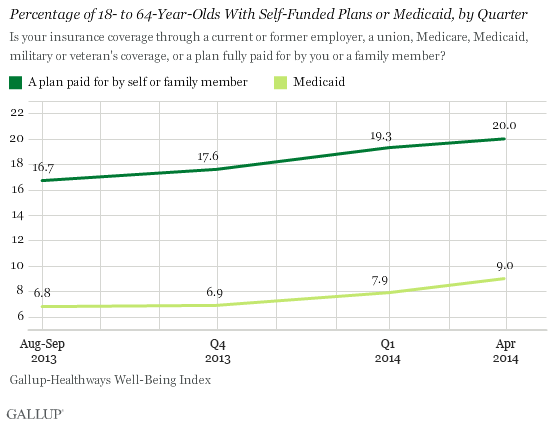WASHINGTON, D.C. -- More Americans aged 18 to 64 report getting health insurance coverage through a plan paid for by themselves or a family member or through Medicaid in April than in the latter half of 2013. Overall, the percentage of Americans under age 65 without health insurance has dropped nearly five percentage points to 16.3% from the 21.2% measured from Aug. 1-Sept. 30, 2013.

These data were collected as a part of the Gallup-Healthways Well-Being Index, and are based on a nationally representative sample of at least 14,000 interviews with U.S. adults each month. Respondents were asked, "Is your primary health insurance coverage through a current or former employer, a union, Medicare, Medicaid, military or veteran's coverage, or a plan fully paid for by you or a family member?" Respondents who said they had a secondary form of health insurance were also asked: "Thinking about this secondary health insurance coverage, is it through a current or former employer, a union, Medicare, Medicaid, military or veteran's coverage, or a plan fully paid for by you or a family member?" Gallup used results for both primary and secondary types of insurance to form a combined estimate on insurance type.
Gallup and Healthways began asking about insurance types using the current question wording in August 2013. Gallup found 16.7% of 18- to 64-year-olds were covered by self-purchased health insurance Aug. 1-Sept. 30, 2013, and that figure has been ticking upward since the state and federal healthcare marketplace exchanges established under the Affordable Care Act opened in October of 2013.
As the enrollment period for purchasing health insurance under the Affordable Care Act wound down in April, 20.0% of Americans aged 18 to 64 reported having a health insurance plan fully paid for by themselves or a family member. This is up slightly from 19.3% in the first quarter of 2014. Americans aged 18 to 64 who report having health insurance through Medicaid rose to 9.0% in April from 6.9% in the fourth quarter of 2013. At the same time, the percentage of those under age 65 who are uninsured is sharply lower in April compared with the first quarter of 2014, and this figure has declined by more than five points since late 2013.
The percentage of Americans aged 18 to 64 who report having health insurance either through Medicare, military or veteran's coverage, or a union has been fairly stable over the last nine months. However, the percentage of Americans covered by a plan provided through a current or former employer decreased slightly in the first quarter of 2014. This decline could be due to several factors -- employers may be dropping coverage for their employees, workers could be opting out of their employers' plans, or some Americans may be leaving the full-time workforce altogether. Regardless, this figure for the month of April was a bit higher than the first quarter of this year.

Overall, the percentage of uninsured Americans among all age groups dropped to 13.4% in April, the lowest monthly measurement since Gallup and Healthways began ongoing tracking in January 2008. The uninsured rate is lower among all adults than it is among those ages 18 to 64 because seniors are eligible for Medicare. Thus, few seniors report not having health insurance.
Implications
The percentage of Americans aged 18 to 64 who are covered by health insurance that they themselves or a family member purchased has been on the rise since the Affordable Care Act's individual mandate and health insurance exchanges went into full effect this year. This increase is likely a direct result of the state and federal health insurance exchanges opening, which gave Americans the opportunity to compare various types of health insurance coverage and purchase individual and family plans. The exchanges were most likely to help those not offered or not eligible for health insurance through their employer, a union, or military and veteran's coverage, and those ineligible for Medicare and Medicaid. Given the way the law is structured, the gains seen in health insurance coverage are most likely to occur in the self-funded and Medicaid categories.
The increase in those reporting having Medicaid for health insurance likely reflects the Medicaid expansion enacted under the Affordable Care Act. A total of 21 states plus the District of Columbia have enacted locally managed state exchanges or state-federal partnerships, coupled with Medicaid expansions. These states have seen lower uninsured rates than those that have not enacted these measures.
Survey Methods
Results are based on telephone interviews conducted as part of the Gallup-Healthways Well-Being Index survey August 2013 through April 2014 with a random sample of 118,000 adults aged 18 and older, living in all 50 U.S. states and the District of Columbia. Quarter 3 2013 results were only from the months of August and September, and were comprised of 24,927 respondents. Quarter 4 2013 results were comprised of 34,333 respondents. Quarter 1 2014 results were comprised of approximately 34,753 respondents. April 2014 results were comprised of approximately 11,695 respondents.
For results based on the total sample of 18- to 64-year-olds for each reported time period, the margin of sampling error is no more than ±1 percentage point at the 95% confidence level.
Interviews are conducted with respondents on landline telephones and cellular phones, with interviews conducted in Spanish for respondents who are primarily Spanish-speaking. Each sample of national adults includes a minimum quota of 50% cellphone respondents and 50% landline respondents, with additional minimum quotas by time zone within region. Landline and cellular telephone numbers are selected using random-digit-dial methods. Landline respondents are chosen at random within each household on the basis of which member had the most recent birthday.
Samples are weighted to correct for unequal selection probability, nonresponse, and double coverage of landline and cell users in the two sampling frames. They are also weighted to match the national demographics of gender, age, race, Hispanic ethnicity, education, region, population density, and phone status (cellphone only/landline only/both, and cellphone mostly). Demographic weighting targets are based on the most recent Current Population Survey figures for the aged 18 and older U.S. population. Phone status targets are based on the most recent National Health Interview Survey. Population density targets are based on the most recent U.S. census. All reported margins of sampling error include the computed design effects for weighting.
In addition to sampling error, question wording and practical difficulties in conducting surveys can introduce error or bias into the findings of public opinion polls.
For more details on Gallup's polling methodology, visit www.gallup.com.
